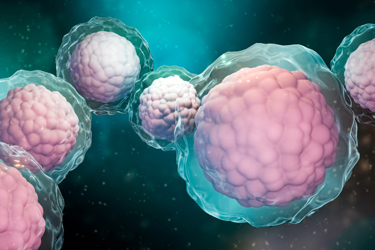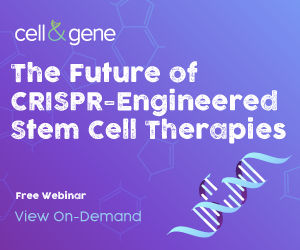Cell Therapy And A New Approach To Allogeneic Hematopoietic Stem Cell Transplant
By Julian Adams, CEO and Ronit Simantov, Chief Medical Officer at Gamida Cell

Allogeneic hematopoietic stem cell transplant (HSCT) — commonly referred to as bone marrow transplant — is a serious but potentially curative procedure that has been used to treat certain blood cancers for more than sixty years. Over that time, outcomes for patients who undergo this procedure have dramatically improved. At the same time, transplant is ripe for innovation that could be provided by the latest advances in the rapidly expanding field of cell therapy.
This is an exciting time to be developing cell therapies as the field is reaching an inflection point that can lead to a major improvement in the lives of patients. Just as the approval of CAR T cell therapies have provided a new treatment for patients in recent years, we believe that we’re on the cusp of delivering a powerful and potentially curative cell therapy to patients that can revolutionize the field of bone marrow transplant.
The Need for Innovation
Though bone marrow transplants have been conducted for decades, and developments in the field have expanded access to more patients, it is estimated that today many patients who are in need of a bone marrow transplant don’t receive one for a variety of reasons, including the lack of a matched donor.[1] Of the approximately 13,000 people every year in the U.S. who have been diagnosed with a blood cancer, only about 8,000 end up receiving a transplant, leaving nearly 40% of patients who do not receive one.
For those patients whose treatment journey culminates in bone marrow transplant, many achieve a cure. But for others, treatment is not always effective and can lead to serious complications that can dramatically affect their quality of life.[2] [3] Immediately following transplant, patients have a high risk of life-threatening complications, especially during the period when their blood counts are low and their immune system is suppressed. A key milestone following transplant is known as neutrophil engraftment, which is a measure of how quickly the stem cells a patient receives in a transplant are established and begin to make healthy new cells. Rapid neutrophil engraftment has been associated with fewer infections and shorter hospitalizations, and engraftment is a key indicator for a patient’s recovery and ability to leave hospital.[4] Therefore reducing time to neutrophil engraftment — even by a few days — has the potential to dramatically improve outcomes for patients by shortening time in hospital and reducing the incidence of infections following transplant.
Challenges in Bone Marrow Transplant
The journey to a bone marrow transplant proceeds in stages. Following diagnosis with a hematologic malignancy, a physician works with a patient to discuss different treatment options. If they decide that transplant is the most appropriate treatment option, they initiate a search for a donor. Patients are matched with donors according to human leukocyte antigen (HLA) type. HLAs are proteins on the surface of cells that signal to the body’s immune system that the cells should not be recognized as foreign and therefore should not be attacked by the immune system.
Today, the search for a donor begins with a patient’s immediate family. If the patient doesn’t have a suitable matched sibling donor, other options are explored, including matched unrelated donors (those who are matched according to HLA type but are not related to the patient) and haploidentical donors (those who share half of the HLA matches and are related to the patient).[5]
Both matched unrelated donors and haploidentical donors provide many patients with bone marrow graft sources each year, but outcomes for patients aren’t as favorable for these graft sources when compared to matched related donors.[6] That being said, the use of haploidentical matches has increased recently, and patient outcomes have been improved by clinical strategies that can reduce graft versus host disease and non-relapse mortality.[7] Using a haploidentical graft source also increases the likelihood of finding a match.
But there are other considerations as well.
There is an association between donor age and outcome for patients, as younger donors lead to better outcomes, regardless of the age of the patient.[8] Our clinical team recently presented data on this topic at the Virtual Cord Blood Connect Meeting in September. The study resulted from a collaboration with the Center for International Blood and Marrow Transplant Research® (CIBMTR®) and was designed to collect and analyze health outcomes data in patients with hematological malignancies who received hematopoietic stem cell transplant or cellular therapy infusion, including bone marrow transplant graft from a variety of donor sources. These data showed that key clinical outcomes — such as time to neutrophil engraftment and overall survival — were improved for patients with donors who were under the age of 30.
Additionally, the systemic racial iniquities that exist throughout our systems of care are particularly visible when it comes to HSCT. The ability to find a matched adult donor varies widely based on a patient’s ethnic background. While white patients have a 77% chance of finding a matched unrelated donor on the Be The Match registry, people from other ethnicities are much less likely to find a match.[9] Strikingly, African American or Black patients only have a 23% chance to find a match; Asian or Pacific Islanders a 41% chance; Hispanic or Latino a 46% chance; and American Indian or Alaska Natives a 57% percent chance.[10]
A Cell Therapy Designed to Expand Access and Improve Outcomes
At Gamida Cell, we are pioneering potentially curative therapies for hematologic malignancies. At the core of our approach is our proprietary NAM technology, which uses growth factors to expand the number of cells in culture while at the same time retaining the cells’ functionality and phenotype.
While our NAM technology platform holds potential to expand any cell type, the most advanced application of NAM is our Phase 3 investigational therapy omidubicel, a potentially life-saving treatment option for patients in need of bone marrow transplant. We believe that omidubicel can potentially expand access to the nearly 40% of patients who do not receive a transplant and improve outcomes for those patients who cannot find a suitable donor.
Omidubicel is intended to address some of the current limitations of bone marrow transplant by providing a therapeutic dose of stem cells while preserving the cells’ functional therapeutic characteristics. The starting point for omidubicel is umbilical cord blood, another type of graft source. The use of cord blood for transplant has been historically been limited because a unit of cord blood may not provide enough stem cells to have a therapeutic effect in an adult. But our NAM technology allows us to overcome this challenge by expanding cord blood units to a therapeutic dose while retaining cellular functionality.
Omidubicel has several potential benefits. Since the cells of a cord blood unit are immunologically naïve, less stringency is needed for matching a patient with a donor, resulting in a higher likelihood of finding a match for a patient. Omidubicel is derived from cord blood, could be considered as the “youngest” cell type used for bone marrow transplant, potentially resulting in better outcomes for patients. In addition, cord blood banks are more diverse than adult donor registries, with 45% of donations provided by white donors and 45% from non-white donors, according to Be The Match.[11] And in a world in which travel is restricted due to the pandemic, omidubicel obviates the need for donor to travel to an apheresis center.
The Phase 3 study for omidubicel has shown striking results.
Compelling Clinical Data
The Phase 3 clinical study of omidubicel is an international, multi-center, randomized study conducted at more than 50 clinical centers in the United States, Latin America, Europe and Asia, and the demographics and baseline characteristics were well-balanced across the two study groups.[12] In May, we announced that the study met its primary endpoint of neutrophil engraftment in the intent-to-treat population of 125 patients aged 12–65 years with acute lymphoblastic leukemia, acute myelogenous leukemia, chronic myelogenous leukemia, myelodysplastic syndrome or lymphoma. Earlier this month, we also announced that the study also met all of its secondary endpoints.[13]
We anticipate reporting the full data set at a medical meeting in the fourth quarter of 2020.
Based on the primary and secondary endpoint data, we are confident that omidubicel could serve as a graft for any patient in need of an allogeneic bone marrow transplant. By providing a readily available bone marrow transplant graft, omidubicel has the potential to become the standard of care for any patient who does not have a suitably matched related donor. And we believe that omidubicel could reach patients by 2021, making transplant more accessible to the 40% of patients who do not reach transplant.
The Future of Transplant
In all our work, our goal is to improve the lives of patients. The potential of cell therapies is enormous, and this growing field will have a major impact on patients in the future. With
omidubicel we hope to provide potentially curative transplants to a greater number of patients and hope to improve outcomes for those patients who are not able to find an ideal match today.
Expanding access to high-quality graft sources is an important. But there are other exciting advances in the field as well, including new developmental therapies, genetic analyses, and post-transplant clinical strategies that have shown early promise. We are extremely pleased to see the transplant community coming together to make meaningful progress for patients and their families.
[1] U.S. Department of Health and Human Services: Health Resources and Services Administration. Bone Marrow and Cord Blood Donation and Transplantation.
[2] Carreras et al. The EBMT Handbook. Springer 2019.
[3] According to data from CIBMTR, overall survival five years after transplant varies due to disease status at time of transplant and donor type as these are the main predictors of survival. For patients with acute myeloid leukemia, CIBMTR states: "The 3-year probabilities of survival after HLA-matched sibling transplant in this cohort was 59% ± 1%, 53% ± 1%, and 29% ± 1% for patients with early, intermediate, and advanced disease, respectively. The probabilities of survival after an unrelated donor transplant were 53% ± 1%, 50%± 1%, and 27% ± 1% for patients with early, intermediate, and advanced disease, respectively." D'Souza, A, Fretham C, Lee SJ, et al. Current Use of and Trends in Hematopoietic Cell Transplantation in the United States. Biol Blood Marrow Transplant. 2020 May 11:S1083-8791(20)30225-1, doi: 10.1016/j.bbmt.2020.04.013, PMID 32438042.
[4] Anand S., Thomas S., Hyslop T., Adcock J. et al. 2017. Transplantation of Ex Vivo Expanded Umbilical Cord Blood (NiCord) Decreases Early Infection and Hospitalization. BBMT 2017; 23:1151-7.
[5] Be The Match. HLA Basics. Available at: https://bethematch.org/transplant-basics/matching-patients-with-donors/how-donors-and-patients-are-matched/hla-basics/
[6] Presentation by Dr. Steven Devine. Unpublished data from National Marrow Donor Program / Be The Match®. Available here: https://investors.gamida-cell.com/news-events/events-presentations/event-details/omidubicel-miniseries-webcast-part-1
[7] McCurdy, Shannon R. Luznik, Leo. 2019. How we perform haploidentical stem cell transplantation with posttransplant cyclophosphamide. Blood 2019. 134 (21): 1802-1810.
[8] Gamida Cell. Gamida Cell Presents Analysis of Observational Data Demonstrating the Impact of Donor Age in Hematopoietic Stem Cell Transplant Outcomes at the Virtual Cord Blood Connect Meeting. September 10, 2020. Accessed October 20, 2020. Available at: https://investors.gamida-cell.com/news-events/press-releases/news-release-details/gamida-cell-presents-analysis-observational-data
[9] Be The Match. Accessed October 20, 2020. Available here: https://bethematch.org/transplant-basics/matching-patients-with-donors/how-does-a-patients-ethnic-background-affect-matching/
[10] Ibid
[11] Be The Match. Accessed October 20, 2020. Available here: https://bethematch.org/transplant-basics/matching-patients-with-donors/how-does-a-patients-ethnic-background-affect-matching/
[12] Stem Cell Transplantation with NiCord® (Omidubicel) vs Standard Umbilical Cord Blood in Patients With Leukemia, Lymphoma, and Myelodysplastic Syndrome (MDS). Available here: https://clinicaltrials.gov/ct2/show/NCT02730299?term=omidubicel&draw=2&rank=2
[13] Gamida Cell. Gamida Cell Announces Positive Topline Data on Secondary Endpoints from Phase 3 Clinical Study of Omidubicel in Patients with Hematologic Malignancies. October 6, 2020. Accessed October 20, 2020. Available at: https://investors.gamida-cell.com/news-events/press-releases/news-release-details/gamida-cell-announces-omidubicel-secondary-endpoints

